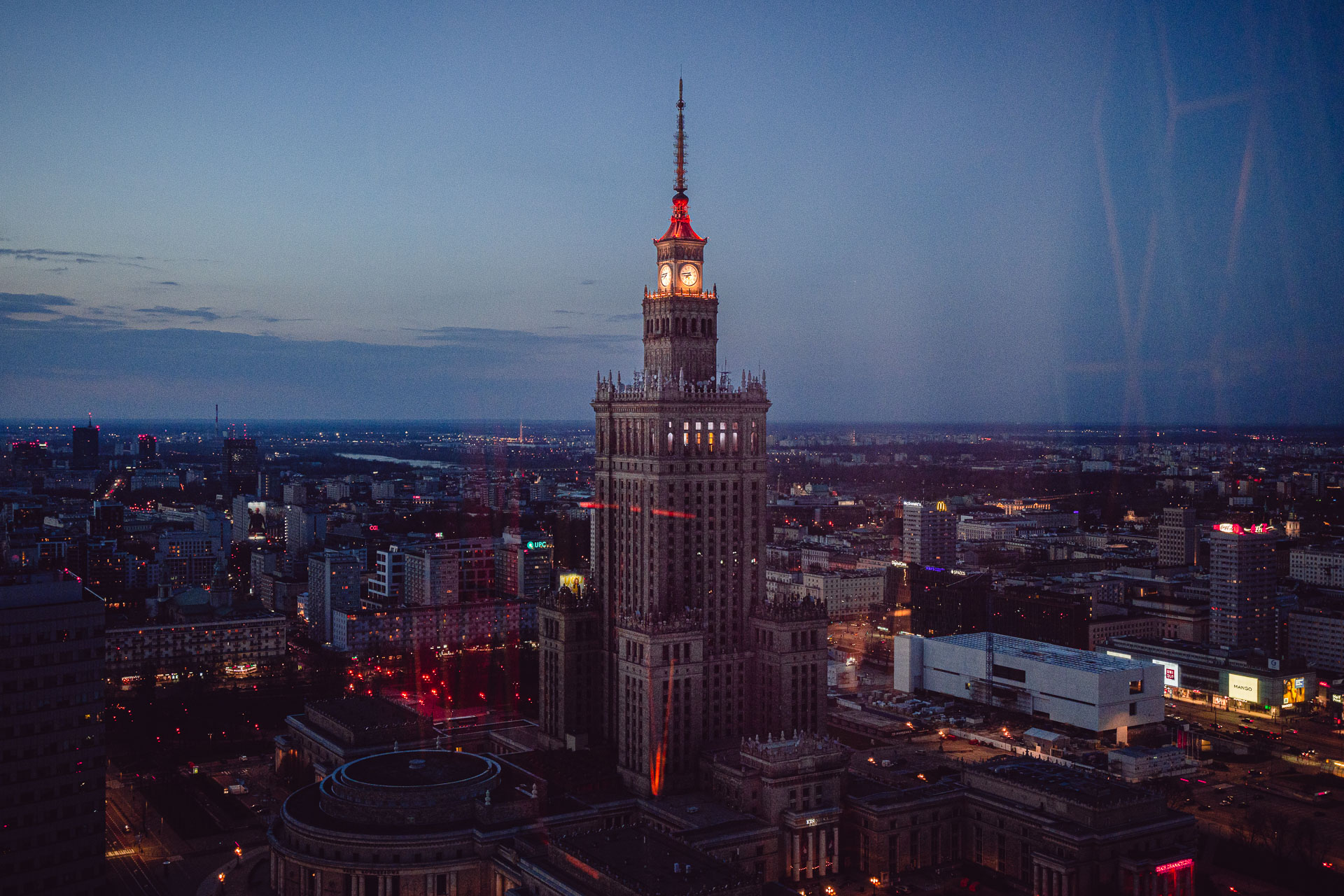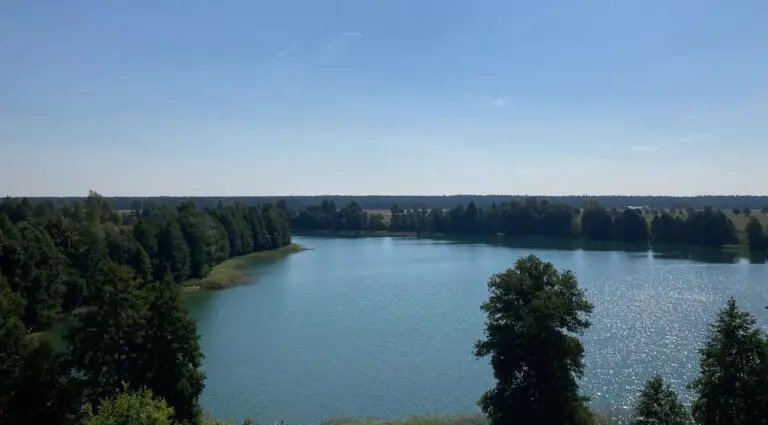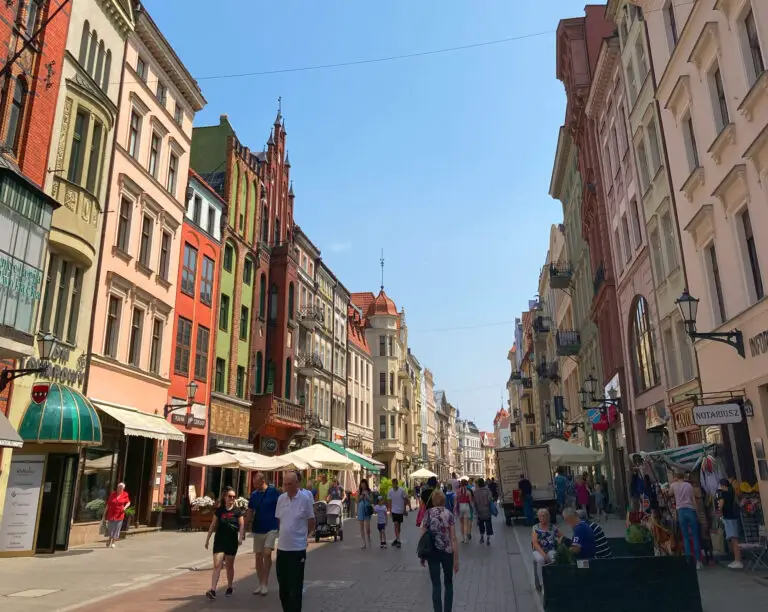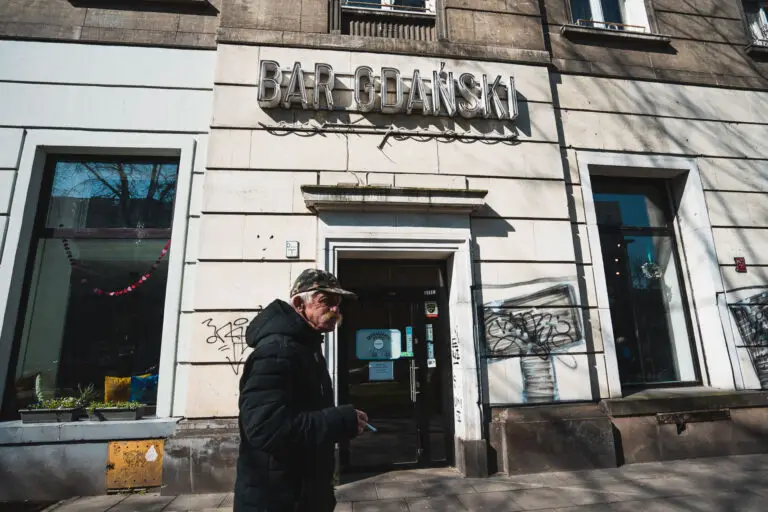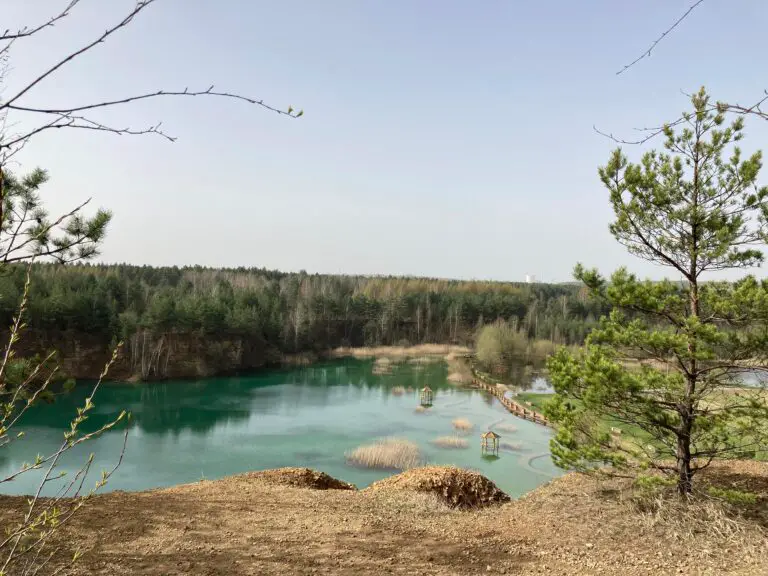20 Most Famous Landmarks in Poland You Must See
What landmarks in Poland are worth visiting? When you think of France, you think of the Eiffel Tower, or Mt. Fuji for Japan. Poland does not have as distinctive as a landmark as those countries. But there are many landmarks in Poland that are 100% worth visiting. Many of these landmarks are within major cities served by many flights year-round, making them easy to visit.
Poland’s landmarks are no different than any other country. Poland has many iconic buildings from many eras of history, such as Malbork Castle or the Palace of Culture and Science. Poland also has many cities, or city neighborhoods, that are landmarks in themselves, such as the Warsaw Old Town. Finally, Poland has many sites of both natural beauty and historical significance that are worth visits, such as the beautiful Morskie Oko, or the sorrowful story told by Auschwitz.
This list holds a list of 20 landmarks in Poland that are worth visiting as centerpieces of a trip to Poland, including many UNESCO World Heritage Sites (marked with a **). There are, of course, many more, but I believe this list has some of the most iconic amongst both tourists and Poles alike. This list holds input from my girlfriend on what she felt were the most important sites of her country, so I thank her for her help.
The landmarks will be organized into categories, and you will find a short description of them, information on hours and cost of admission, and travel information. I hope you find one, two, or five landmarks worth visiting on this list!
Landmarks in Poland: Buildings
1. Wawel Royal Castle
Kraków, Lesser Poland | Location | Website
Description: Wawel Castle is perhaps the most significant landmark in Poland, hence its top placement on this list. So much of Polish history has happened in Kraków, the former capital of Poland, and much of the history happened on the hill overlooking the Vistula River. Kings were crowned, influential laws were passed, and wealth was looked for on this hill, which houses the castle, a few other buildings, and an impressive cathedral. Today, it is all a part of one museum, and is highly visited by Poles and tourists alike.
Planning to visit Poland soon?
🛫Booking flights to Poland: For booking flights, we love to compare prices on Expedia and Kayak.
🛏️Booking hotels in Poland: When looking for hotels, we recommend using Booking.com and Hotels.com. We stayed at a couple of hotels in Poland and liked the following ones:
- Sofitel Warsaw Victoria (Warsaw)
- Hotel GEM (Wrocław)
- INX Design Hotel (Krakow)
⛪Booking tours in Poland: Viator is a great platform for finding tours and excursions to join.
🛣️Renting a car in Warsaw: Discover Cars is the platform we use when renting a car in Poland.
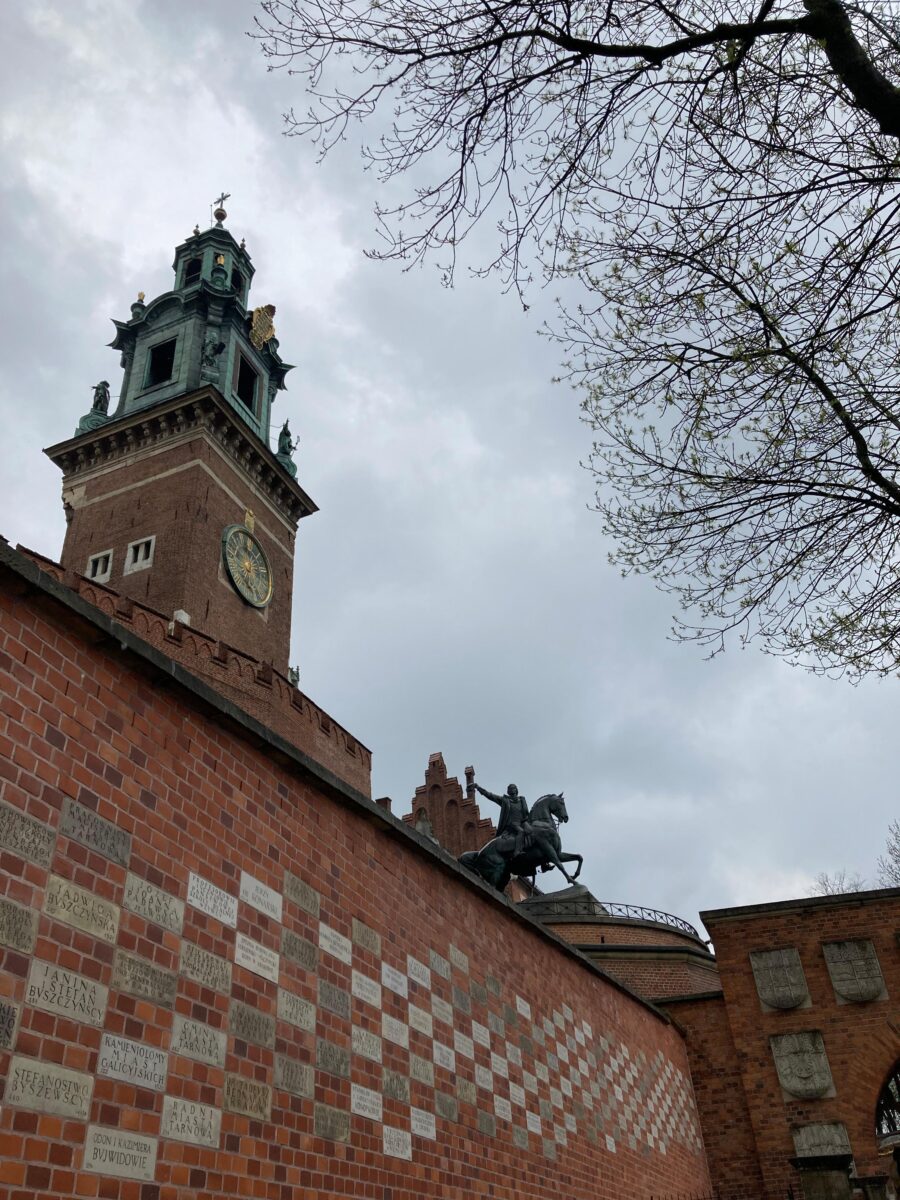
There are many rooms to see. Some of the most significant are the Royal Private Apartments, home to famous Polish kings and queens of centuries ago, and the State Rooms, where many important decisions were made. You can also visit the crown treasury and armory to see the huge collection of goods that were collected by the Polish royal family, with this collection only being a small percentage of what was after the castle was pillaged during WWII. If you do not want to go inside, Wawel Hill is a great place to relax, you do not have to have a ticket to walk on the grounds. Overall, this is a landmark in Poland you do not want to skip.
Opening Hours: Because there are so many different parts to the museum, it is best to check the website for the hours. They change based on the season and the day of the week, with shorter hours on Monday due to it being free. There will also be some upcoming closures of some of the rooms, so again check their website for the exact information related to that.
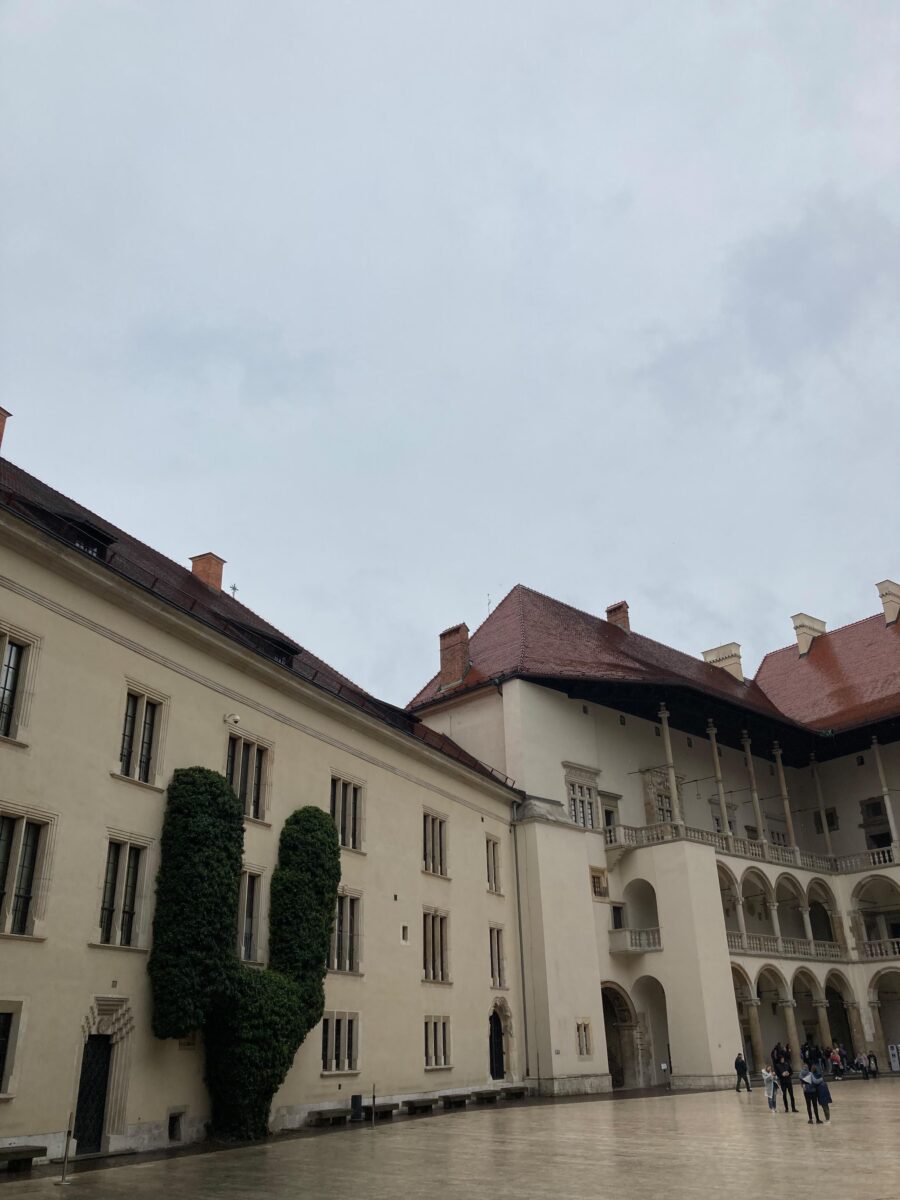
Cost of Admission: Each area of the castle can be bought with a separate ticket. Thus, Monday is one of the best days to visit, since admission is free to some of the exhibits. If you cannot go, each of the exhibits ranges from between 15 and 35 PLN, or 10 and 25 reduced. And, while some of the grounds are freely open, some are not, and you must buy a ticket around 10 PLN to walk some castle routes. Tickets can be bought online, but there is an online fee of 1 PLN per ticket to do this.
Travel Information: If you are coming to Kraków, which is the most visited city in Poland, you will not be able to miss the Wawel Castle. It is connected to the Main Square (more on that later) and is by the Vistula Promenade. You can walk there from the city center in about 15 minutes, but there are also buses and trams that stop nearby.
2. Malbork Castle **
Malbork, Pomerania | Location | Website
Description: Malbork Castle is one of the most impressive landmarks in Poland. It is considered the largest brick castle in the entire world. It was originally built by Teutonic Knights back in the day when this region of Poland was in different hands. The impressive structure served as a bastion of safety from opposing armies. Eventually, it was sold to the Polish royal family, and became a royal residence. Its impressive stature and history today make it an illustrious UNESCO World Heritage Site.
Today, the castle is a massive museum. Purchasing a ticket will allow you to walk around the castle grounds, and weave in and out of the many rooms inside the castle, where you will learn about the history of the castle, see some artwork, weapons collections, and enjoy views of the next-door river. Once you finish, you can enjoy the market that happens outside, or enjoy a beer with a view of the castle. If you find yourself in the area, this landmark in Poland is certainly a must visit!
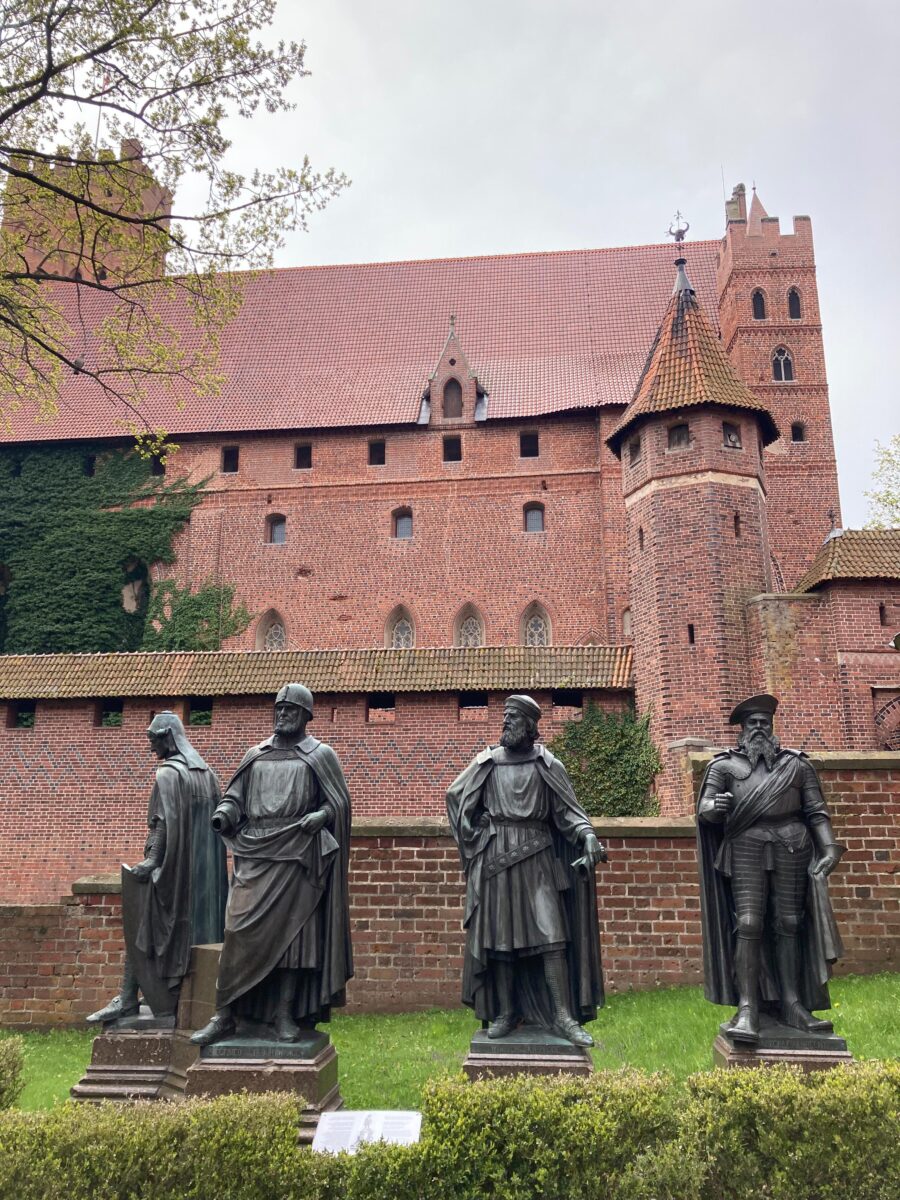
Opening Hours: The opening hours for Malbork are very complicated. There are two different routes, the Green and Historical route, and some routes are not available every day. Also, the hours change constantly based on what season of the year it is. Thus, I recommend checking the castle’s website, linked above, for the up-to-date schedule, and for which routes are open on which day. The castle closes earlier in the winter like many Polish attractions, however.
Cost of Admission: The castle is a little pricey, at 70 PLN or 50 PLN reduced. If you are a family of, you can get a small discount for 2 adults and 2 children for 220 PLN. I recommend buying tickets online to skip the lines that can generate due to many tourist groups that come here from Gdańsk.
Travel Information: Gdańsk is the closest major city to Malbork. There is a regular train service, both regional and inter-city, from Gdańsk every day, the train only takes about 30 minutes each way. You can also take a train to Malbork from Warsaw on the route to Gdańsk without too much trouble. There is a lot of parking available if you are arriving by car.
3. Wilanów Palace
Warsaw, Mazovia | Location | Website
Description: I have sung the praises of this beautiful palace in other articles for this blog, naming it one of the best museums in Warsaw as well as one of the most romantic places to visit, and this blog will be no different. This beautiful yellow and white building is a remnant of the Polish monarchy, and one of the best preserved, as it survived WWII mostly intact. Here you will find perfectly manicured gardens, beautiful sculptures, and serene places to sit down and enjoy the environment, as the former owner intended when he made the palace open to the public centuries ago. It is one of the true landmarks in Poland.
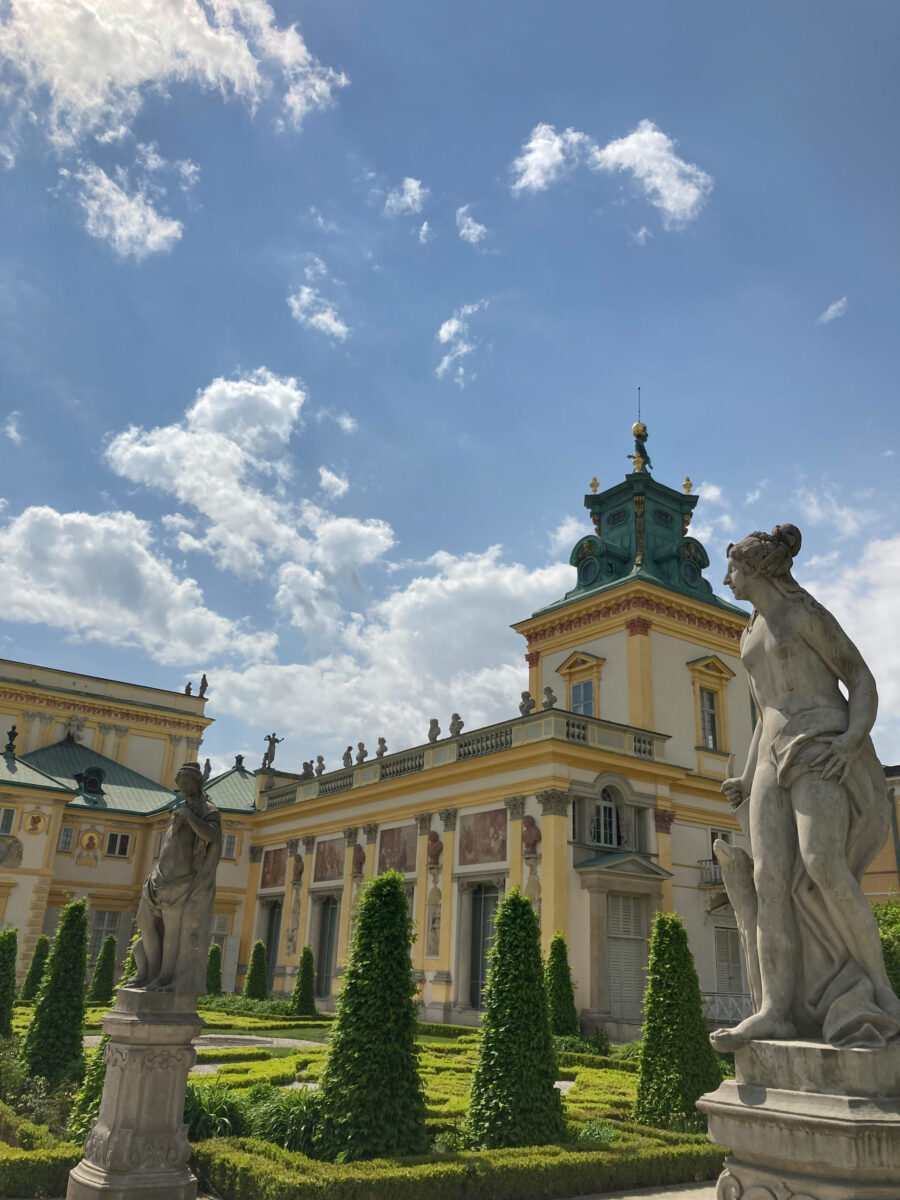
Now, you can just enjoy the gardens, or you can gain admission to the museum inside the palace. Inside you will find decadent bedrooms that formerly housed queens and kings, artwork everywhere, some of the largest collections of oriental art and supplies in Poland, and other wonders. Walking around the palace is a perfect way to spend a few hours on a day in Warsaw and is a must see for any length of stay in Warsaw.
Opening Hours: The hours for the museum are every day from 10 AM to 4 PM. The gardens are open longer each day, but it depends on when you are coming (it closes earlier the earlier the sunset), so check the website for more info.
Cost of Admission: A regular ticket costs 35 PLN, and a reduced ticket costs 28 PLN for the museum, with children up to 6 free. You can also just choose to enter the park, for 10 PLN or 5 PLN reduced. Entry to both the park and museum is free every Thursday. You can book tickets online except for on Thursdays, when you must pick tickets up at the box office.
Travel Information: If you are arriving in Warsaw, there is a regular bus service to Wilanów from the city center and the Old Town. A bus will take around 30-45 minutes depending on how bad the traffic is, especially as construction is ongoing in the area for a new tram line.
4. Palace of Culture and Science
Warsaw, Mazovia | Location | Website
Description: The placement of the Palace of Culture and Science (or PKiN) on this list of landmarks in Poland may be controversial to some Polish people. However, there is no denying how iconic this building is, despite the complicated history and memories this building evokes for many Poles. This 237-meter (778 ft) building was originally a gift from ruthless Soviet dictator Stalin to his allied (by force) neighbor Poland. It was built in the Stalinist style, and you will find other buildings that look like twins of PKiN in former Soviet cities, such as Riga or Moscow.
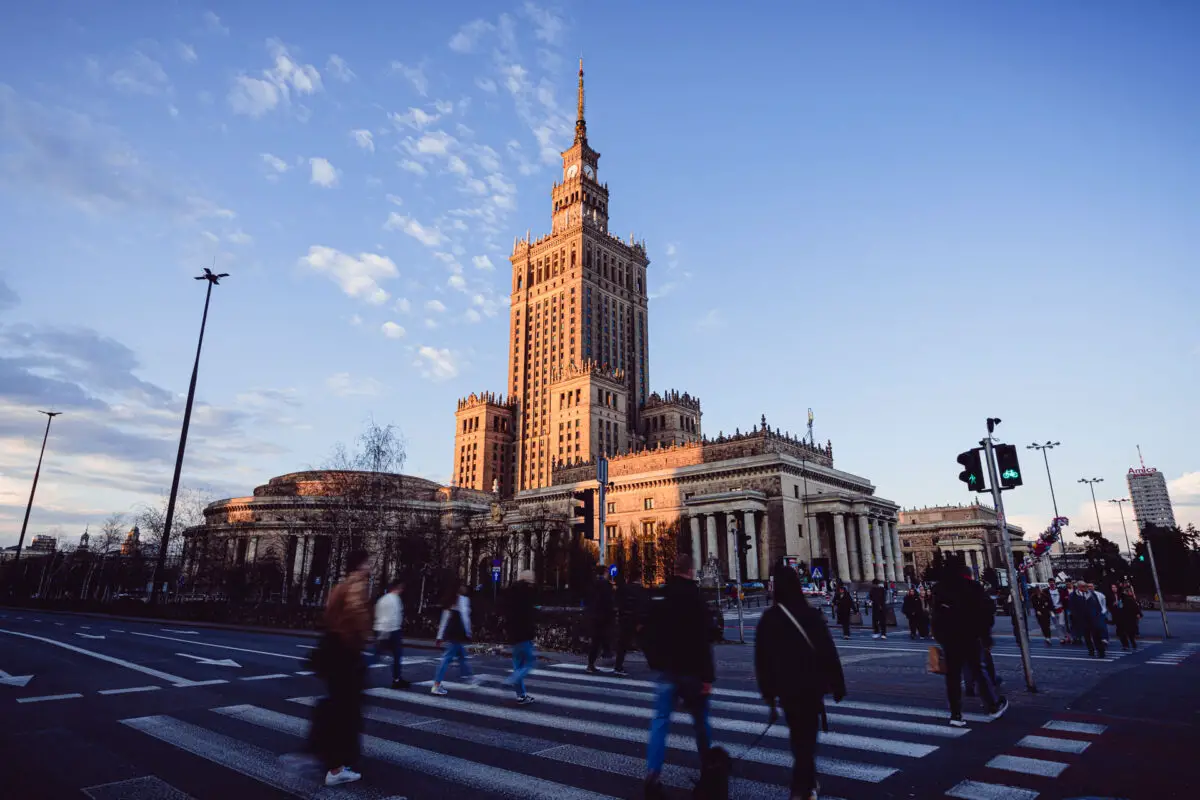
So, while this building represents a very tough time of history to some, there is no denying the building is stunning and distinctive. It towers above the surrounding area, and its placement on a huge plot of land with no other tall buildings helps it stick out in the skyline, even as a taller building has been built next door. This building houses museums, concert halls (that once hosted the Rolling Stones), and at the top, an observation deck that currently supplies the best views of Warsaw. Go when it opens to beat the crowds or at sunset to get a stunning view.
Opening Hours: If you just want to see the tower, you can do it at any time of day. Inside you will find some museums that may interest you, so check their individual hours. For the viewing deck, the hours may change, but are typically 10 AM – 8 PM, with closures on major holidays.
Cost of Admission: A normal ticket costs 25 PLN and a reduced ticket costs 20 PLN. It is recommended to buy tickets ahead of time during the busy season, or if you have a particular time you want to visit.
Travel Information: PKiN is easy to get to in Warsaw. It is right next to the central railway station, and you can get there directly from either Chopin or Modlin airport. It is well-served by public transportation, including many trams, buses, and both metro lines. Because it sticks out, you won’t miss it if you want to walk to it from a hotel in Warsaw.
5. Poznań Town Hall
Poznań, Greater Poland | Location | Website
Description: Poznań is, in my opinion, one of the most underrated cities to visit in Poland. At the center of this bustling city of over 500 thousand people is one of the most beautiful landmarks in Poland. The Poznań Town Hall is a beautiful building found in a market square that was formerly the center of the local government, that currently sits as a beautiful centerpiece for photos, with a museum found inside as well. The building has existed since the 13th century, but its current format was built in the middle of the 1500s. It is, quite simply, a stunning building.
As you walk around you can appreciate the many arches full of artwork, small towers, and the tall central clock tower. In this clock tower is a special show that is performed on the hour, with a bugle call. At noon, you can see two mechanical goats butt heads, which was initially added as a comical addition, and these goats have lived through a lot of mishaps in their history. Walking inside will take you through the Museum of the History of the City of Poznań, where you can learn about the diverse and long history of the city.
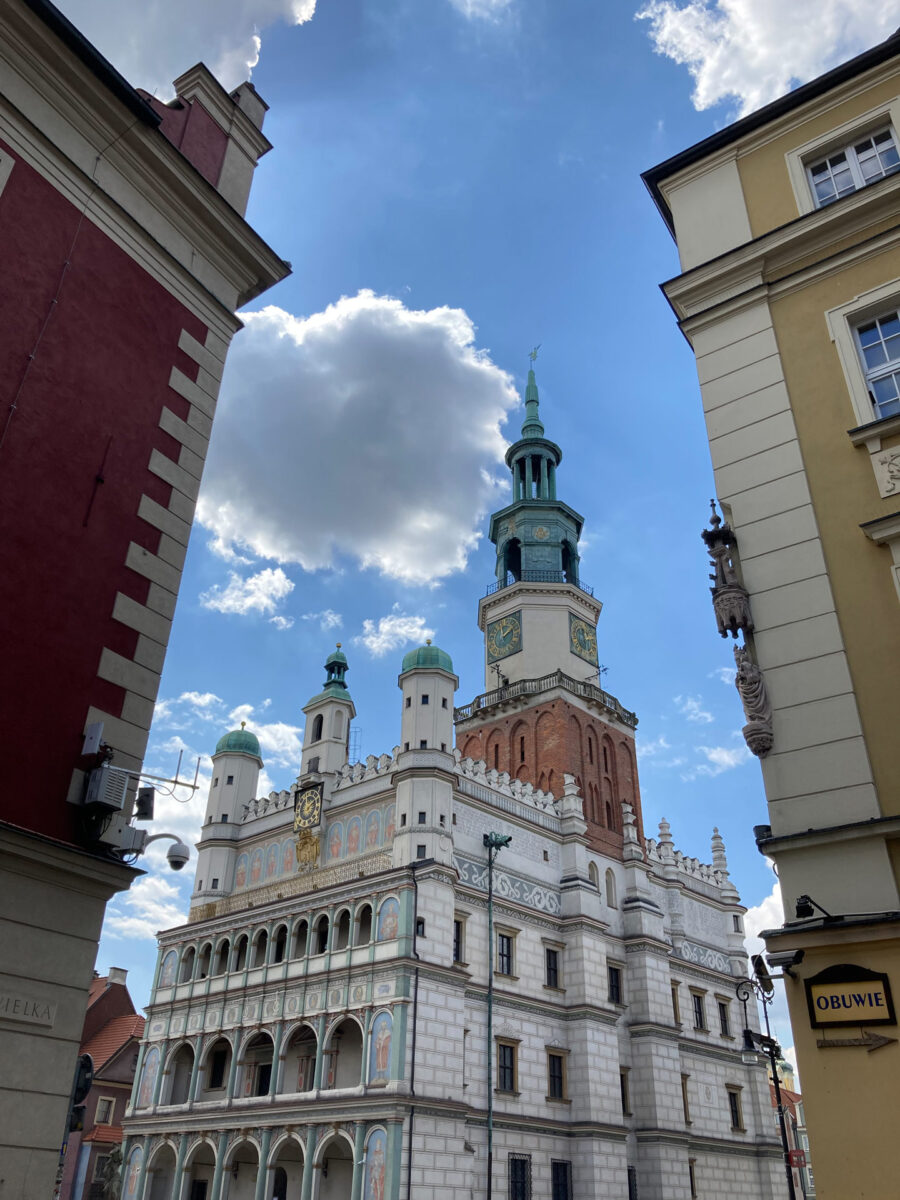
While this building is beautiful, and a must see if you are in the area, unfortunately its beauty is diminished at present. The city is doing long-needed renovations to the market square surrounding the building. When I visited in May of 2022, this just meant fences around the building, but currently, this means that there is constant construction work, with the cobblestone square being completely torn apart, and fences everywhere. But this is supposed to be finished by 2024 for my readers in the future (the original date was summer 2023). Regardless of the construction, the rest of the city is worth a visit, and this building is still beautiful, no matter what construction is happening.
Opening Hours: Currently the museum inside is temporarily closed as construction continues to happen. You can view the outside of the building at any time of the day, but of course, with construction ongoing, the best time is early in the morning or in the evening, when the construction has stopped for the day.
Cost of Admission: Not applicable
Travel Information: Poznań is a well-connected city in Poland. It is approximately 3 hours by train from both Warsaw and Berlin. It is served by its own airport as well that does have budget flights from certain destinations, or flights from within Poland with LOT, the Polish airline. Once in the city, you will likely be drawn to the historic area of Poznań, and there you will find this landmark in Poland.
6. Wrocław Town Hall
Wrocław, Lower Silesia | Location | Website
Description: Wrocław is perhaps the most beautiful city in all of Poland. Full of colorful buildings, and scenic islands on the Oder River, the center of it all is the Market Square. Here you will find the Wrocław Town Hall, an icon of the city and a beautiful landmark in Poland. The building is in the gothic style, full of bricks, fancy roof adornments, towers of various lengths, a clock and other typical gothic features. The building is relatively well preserved and has been around since the 13th century at the earliest.
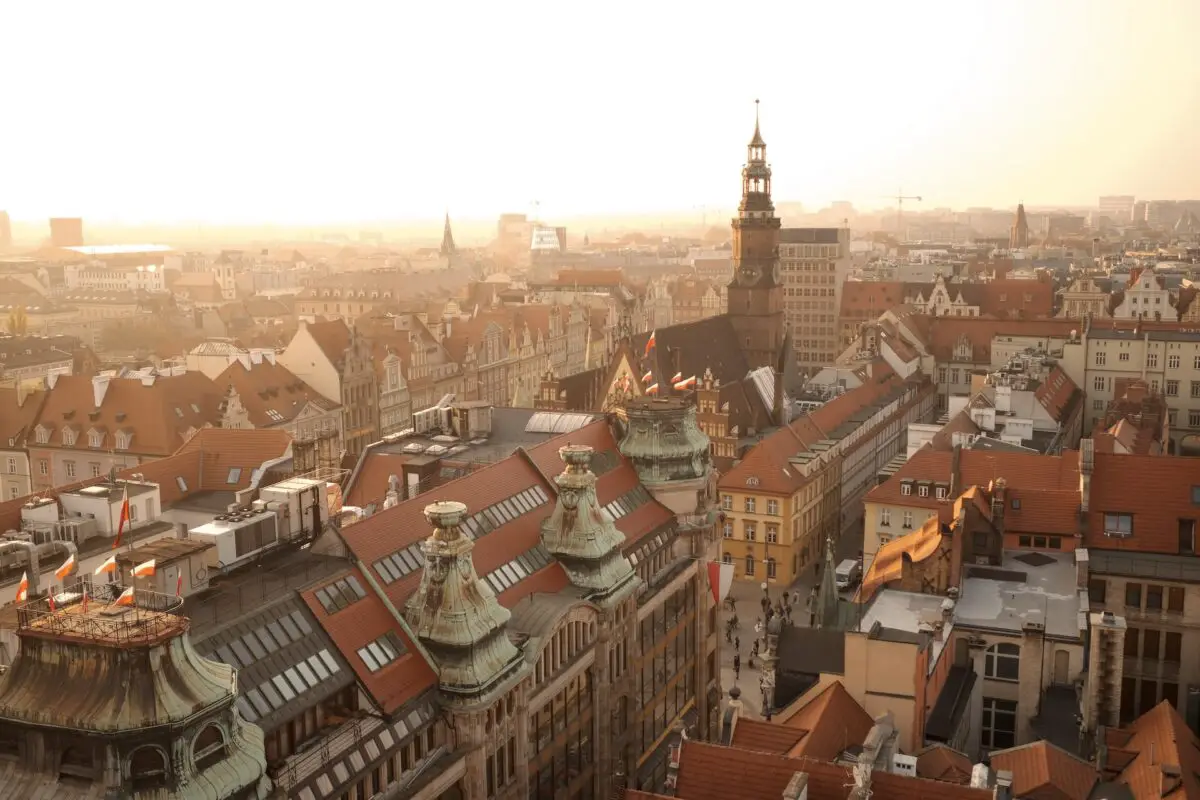
While admiring the outside and taking a few pictures is certainly the main highlight, you can also enter the building and see the inside. The building houses the Museum of Bourgeois Art. While there is some art spread throughout the museum, you also get to see most of the Gothic interior, from the Great Hall to the Princes Room, while admiring paintings along the way. Overall, Wrocław is a city of note to visit in Poland (be on the lookout for some features soon as I go there for the first time), and the Town Hall is the most impressive building amongst the many different architectural styles found in Wrocław.
Opening Hours: You can walk around the Town Hall anytime. If you would like to see the inside of the Town Hall via the museum, it is open from Wednesday to Sunday each week, with hours from 11 AM to 4 PM on Wednesday, 11 AM to 5 PM from Thursday to Saturday, and 10 AM to 6 PM on Sundays.
Cost of Admission: The cost of admission to see the inside of the Town Hall via the museum is at present 15 PLN, or 10 PLN reduced, with extra charges for seeing the temporary exhibition at the time. The inside is free to view on Thursdays.
Travel Information: Wrocław, as one of Poland’s largest cities, is well-connected to other Polish cities. Its placement near Poland’s borders with Germany and Czechia mean it is also well-connected internationally. There is regular bus service from within Germany, from Prague, and from Warsaw and the Katowice area. Or you can fly to Wrocław International Airport, which is served by budget carriers, including lots of service from Wizz Air. Once in Wrocław, the Town Hall is directly in the center, with bus and tram service surrounding it.
BONUS:
Need some more buildings to visit? In Wrocław, you can visit Centennial Hall, the hundred-year-old building that has been host to many major events, concerts, and more in Polish history. Built prior to WWWI, this building has stood the test of time, and was once the largest concrete dome in the world. It is an easy site to visit when already in Wrocław, but is not something to build a trip around, hence why it is not on the list proper.
Also, there is a high chance that whatever town you pass through might have some historic churches, some that may even be on the UNESCO list. Churches are some of the most cherished buildings in Poland, which is unsurprising considered its long history of Catholicism, but also religious tolerance. So, wherever you plan to go, look for churches, and you will likely find a beautiful building to visit and appreciate.
Landmarks in Poland: Cities
7. Warsaw Old Town **
Warsaw, Mazovia | Location | Website
Description: In pretty much every list I have ever made, I find an excuse to include the Warsaw Old Town if possible. Simply put, it is one of the best attractions to visit in Warsaw, and one of the best landmarks in Poland. The beautiful Old Town has been around for centuries, but the current rendition is one of the main reasons Warsaw is called the phoenix city. With much of Warsaw destroyed after WWII, this part of the town was painstakingly rebuilt from scratch, to appear as it did once before. Now, it is as beautiful as ever, and its beauty and history have helped it become a member of the UNESCO list.
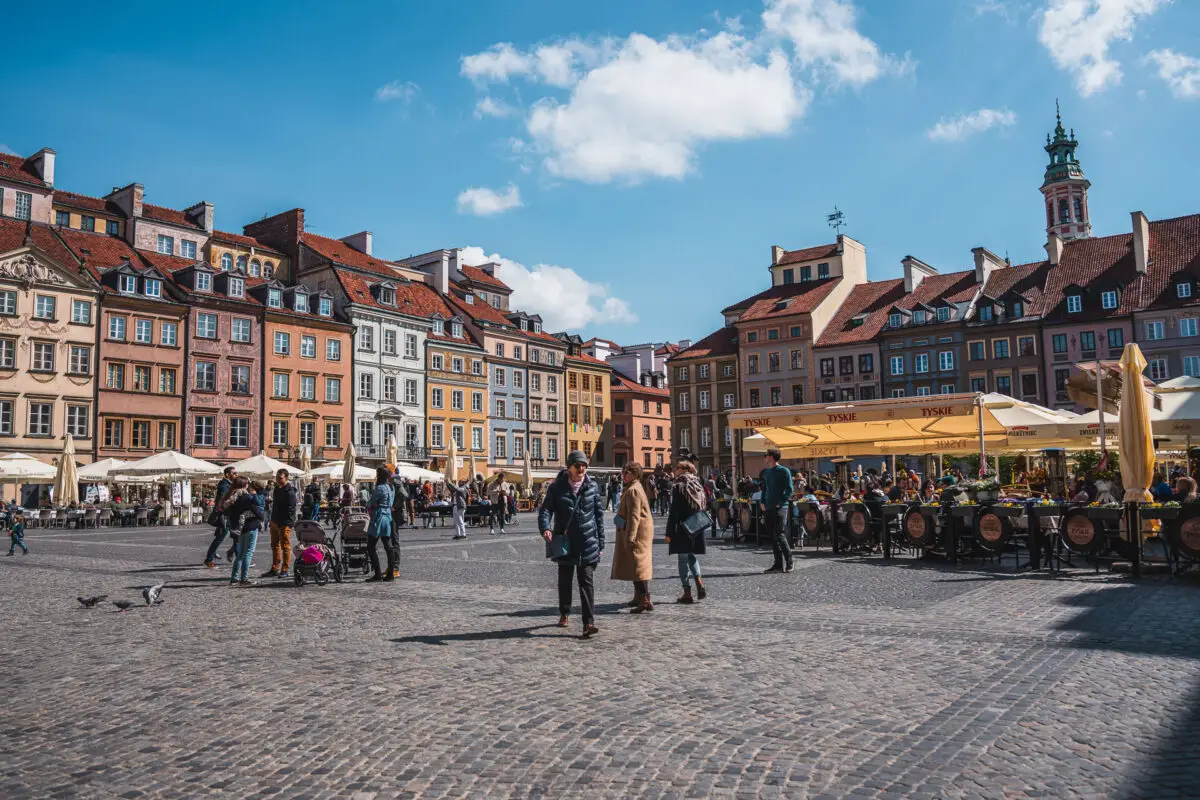
The main highlight of the Old Town is the Market Square, where you can see all the beautiful colorful buildings surrounding the iconic statue of a mermaid that is Warsaw’s symbol. You will find restaurants here to eat at, and in the winter, you will find a small market with ice skating. It is also fun to walk down some of the narrower alleyways in the Old Town, to find even better restaurants that are less busy and cheaper, and buy some ice cream, or a souvenir.
The Old Town has a few other attractions to keep you busy. You can visit the beautiful St. John’s Cathedral with its staircase-like roof, and organ concerts and tombs of kings. You can visit the Royal Castle in Warsaw and get a history lesson while admiring the decadent interior and exterior. Or you can enjoy a free walk along the city walls and by the Barbican, where you find some shade on a hot day, or the Christmas Market in the winter.
Opening Hours: The opening hours depend on the attraction you are planning to visit, but of course you can walk around the Old Town 24/7. I would say the best hours are in the morning, or after dark. You will get the most peace and quiet, and in the evening, you can enjoy the beautiful lights that adorn the area.
Cost of Admission: Visiting the Old Town can be entirely free. Some museums will range between 20 and 40 PLN to visit, with the Royal Castle being the most expensive museum in the Old Town.
Travel Information: The Old Town is very well connected to the rest of Warsaw. The Royal Route is directly south and has a bus service on it from the north and south. There is also a dedicated tram stop, with a tram service from the Old Town. Both the M1 and M2 metro lines are not far as well. One bus that serves near the Old Town is Bus 175, which arrives directly from Chopin airport. The least busy times to visit are anytime between October and March, the extended winter of Warsaw.
8. Kraków Main Square **
Kraków, Lesser Poland | Location | Website
Description: The Main Square in Kraków is up there with the Old Town of Warsaw as one of the most stunning landmarks in Poland. This hub in the Old Town of Kraków was the main place of commerce and activity for centuries, including the many years where Kraków was the royal capital of the kingdom of Poland. Thus, there is much history to find here, starting in the Cloth Hall in the center of the square. Today you will find lots of cheap and typical touristy souvenirs to buy but keep an eye out above the booths for the painted crests of the cities of Poland.
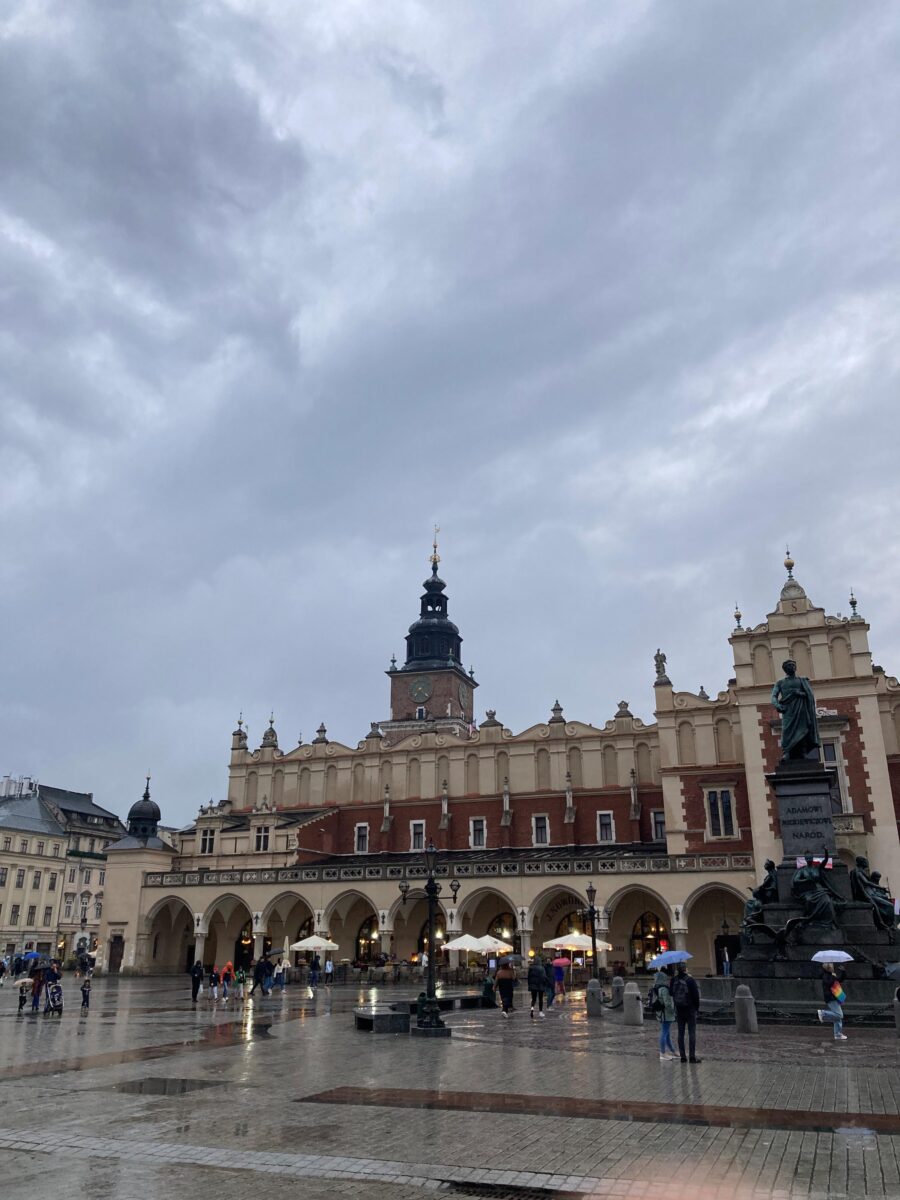
You will also find the St. Mary’s Church right next to the Main Square, which combines with the Main Square to be part of the UNESCO list. The interior of the church is beautiful, but on the outside, you can admire a unique tradition. Every hour on the hour, a bugler in the top of the tallest tower of the church works his way around each of the windows in the tour, and gives a call to those watching, waving to onlookers as he finishes. The basis of the tradition is much debated, but it is a must to experience when in Kraków.
Overall, you should appreciate the many beautiful buildings on the Main Square while visiting, and maybe enjoy a coffee or a bite to eat at one of the many restaurants around the outside of the square. At night, this area becomes party central, as party tourists take over the square, so I recommended avoiding the square at this time
Opening Hours: The Market Square is always open, and usually has some people there at all hours. The vendors in the Cloth Hall are open for most of the working hours during the day. You can visit St. Mary’s Church from Monday to Saturday from 11:30 AM to 6 PM, and on Sundays and holidays from 2 PM to 6 PM.
Cost of Admission: The main costs of this area are whatever you choose to buy. If you would like to enter St. Mary’s Church, a donation is required of 15 PLN or 8 PLN reduced, with admission free for those under 8.
Travel Information: Kraków is a well-connected city. There is train service from every major Polish city to get there. The Kraków Airport is also one of the busiest in Poland, and there are flights here from all over the world, including most of Europe and some cities in the US. Within the city, the Market Square is right in the center of all the activity in Kraków, and is mostly a pedestrian-only area, so be prepared to walk a bunch when exploring the area.
9. Gdańsk Old Town
Gdańsk, Pomerania | Location | Website
Description: Gdańsk is, in my opinion, the most beautiful city in all of Poland. Part of the beauty comes from the uniqueness of the Gdańsk Old Town. This Old Town, like Warsaw, has also been rebuilt after destruction during WWII, and the result makes it one of the most impressive landmarks in Poland. And because Gdańsk has not always been a part of Poland throughout its history, once known as the Free City of Danzig, the architectural style is different, with narrow colorful houses lined up together in neat rows, with canals and other waterways working their way through the houses.
There are lots of sights to see within the Old Town, centered on Długi Targ, the long street in the heart of everything that stretches from gate to gate. Closer to the canal you will find a large open space surrounded by restaurants and clubs, with the Statue of Neptune in the middle, a symbol of the maritime importance of Gdańsk. You will also find the Town Hall. You can learn the history of the city inside or climb your way to the top of the tower for, in my opinion, the best view in Gdańsk. You may also be treated to a concert of bells at noon.
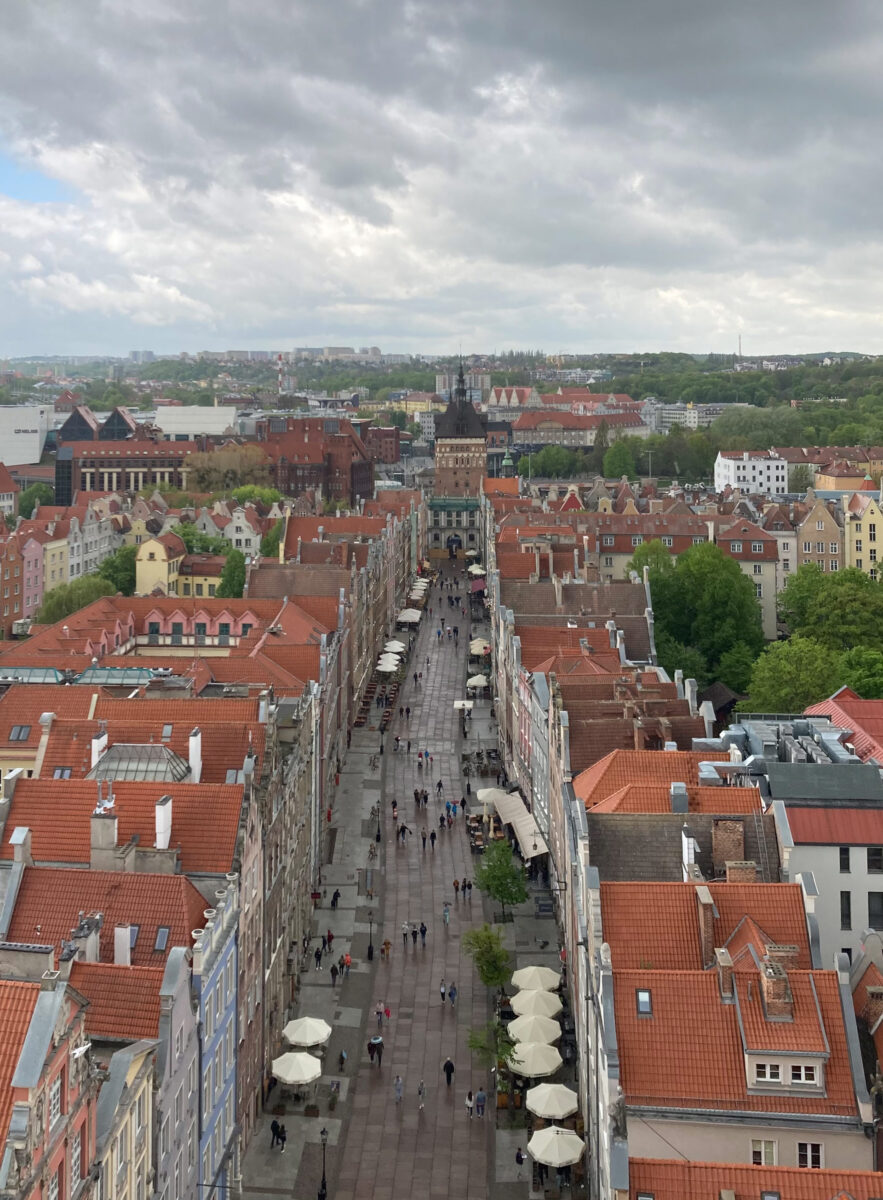
Other sights in the Old Town include St. Mary’s Church, whose interior is impressive and typical of Polish churches, and has the benefit of being free. You can also climb to the top for a fee, although the staircase makes it not as accessible as at the Town Hall, and you have less space on the top to see. Other than that, take a walk along the canals, find a nice restaurant, admire the old crane, or sit down on a bench and enjoy all the wonders of the Gdańsk Old Town.
Opening Hours: As with all cities, you can walk around the Old Town 24/7. Of the two sights I mentioned, St. Mary’s Church is open from 9 AM to 6 PM every day except Sunday, when it is open from 1 PM to 6 PM. The Town Hall is open from 10 AM to 6 PM every day except Monday, when it is only open from 12 PM to 6 PM. The view tower in both places may be closed during bad weather, including a tiny bit of rain (as I experienced).
Cost of Admission: Walking around is of course free. St. Mary’s Church’s view tower costs 10 PLN, and slightly less reduced (I think around 7 PLN). The Town Hall is free on Mondays, but otherwise costs 23 PLN or 16 PLN reduced.
Travel Information: Gdańsk is one of the most visited cities in Poland and is served by a busy international airport not too far out of the city, which is connected by city train and bus. You can also easily get to Gdańsk from Warsaw. The Old Town is in the southern part of Gdańsk, the first place you will most likely arrive. It is mostly a pedestrian zone, so be prepared to walk to see the sights.
10. Toruń Medieval Old Town **
Toruń, Kujawa-Pomerania | Location | Website
Description: For the final Old Town on our list, we must visit Toruń, one of Poland’s oldest and most historic town. Part of a variety of empires throughout its history, which started in medieval times, the Old Town remains from that era as it was, as Toruń was mostly spared during WWII. This makes Toruń a great city to visit, and in my opinion, it is severely underrated by tourists coming to Poland.
The city has a rich history, both literally and figuratively. The town was populated by merchants, who combined local products with spices brought from the east to create a Polish staple, this being gingerbread. While it is not 100% clear, Toruń gingerbread was perhaps the first commercially sold gingerbread in all of Europe and is still famous today. When visiting the Old Town, you will find many places to buy some using the Toruń recipe.

The other reason to visit is related to Nicolaus Copernicus, Toruń’s most famous resident. Here you will find museums dedicated to him, including the house where he might have been born, which today houses a museum. Generally, as you learn the history, you should also walk around and see the many beautiful buildings, churches, and cathedrals, as well as the city walls, many in the beautiful brick gothic style. For a more comprehensive review of Toruń, check out my blog on the city.
Opening Hours: The Toruń medieval Old Town is open at all hours. The many museums in the Old Town are open for typical hours, usually from 10 AM to somewhere between 4 and 6 PM depending on the season.
Cost of Admission: Walking around the Old Town is entirely free. The museums cost what they typically do, between 15 and 30 PLN per person. Buying gingerbread to eat will probably cost you anywhere between 10 and 20 PLN, or more if you choose to buy a lot.
Travel Information: Toruń is slightly isolated from the main cities of Poland, but it is still not difficult to get to. It is well-served by trains from Warsaw, Gdańsk, Poznań, and Łódź, with a train from each of these destinations taking between 2 and 3 hours. There is also a FlixBus service to Toruń from Warsaw that runs many times per day. The closest airport with international service is in Toruń’s sister city of Bydgoszcz.
11. Zalipie
Zalipie, Lesser Poland | Location | Website
Description: Zalipie is the smallest city in this list by for, small enough to be considered a village by the Polish government. Why, then, would you visit this small village about 90 minutes from Kraków by car? Zalipie brings in tourists due to its unique house painting. That is, many of the houses and buildings in the village are covered by folk paintings of flowers. The beautiful houses are one-of-a-kind in all of Poland.
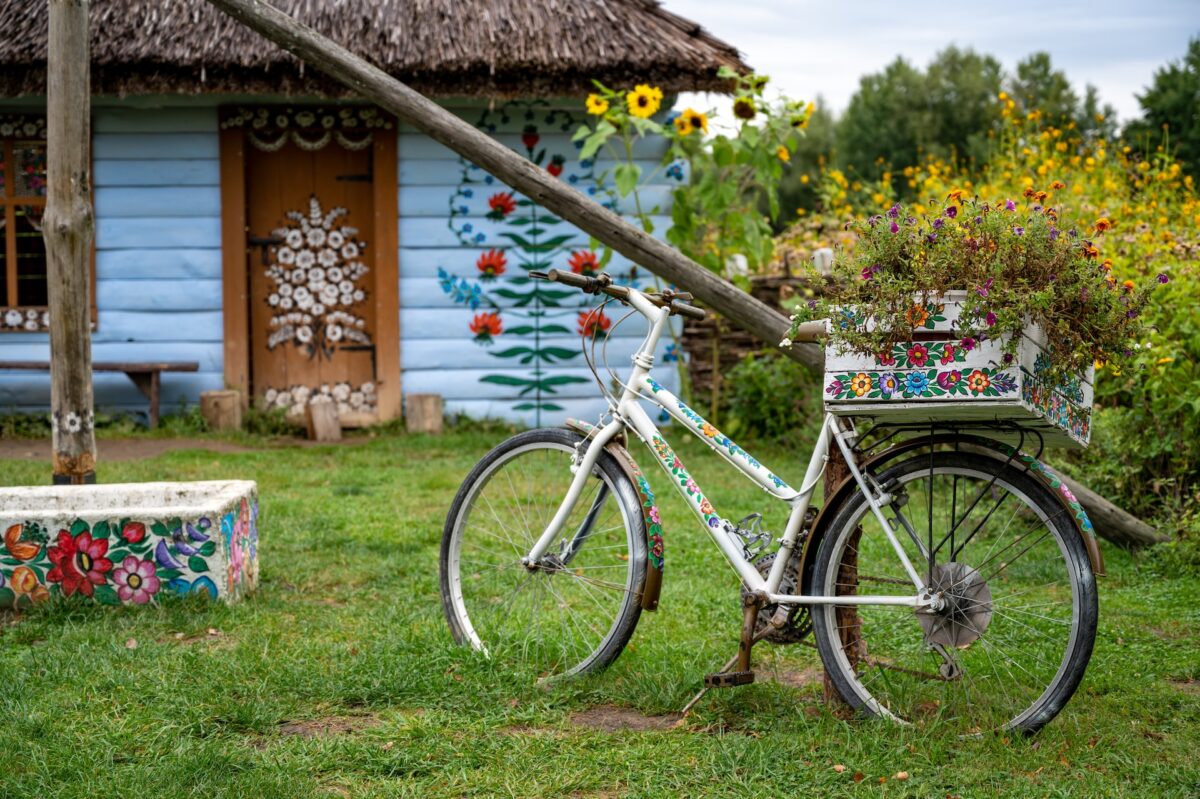
The best place in Zalipie to see these floral designs is at the Homestead of Felicja Curyłowa, the painter who lived in the village and painted many of the designs you can see today. The most striking sights are the house itself, the stable, the barn, and the beautiful painted well. While there is not much else to see in Zalipie beyond this artwork, the charm, individuality, and unique flair makes it worth a day trip. If you want an extra special trip, you can also book private tours with many companies from Kraków.
Opening Hours: The village is always able to be visited, but daylight hours are certainly the best time to visit. The homestead is open Tuesday to Sunday with varying hours each day based on the season as well, so check the website linked for more information.
Cost of Admission: A regular ticket costs 12 PLN, and a reduced ticket costs 9 PLN. There are also family tickets available, as well as guides and lessons. On Thursday, admission is free, but be aware that only 25 people can enter the museum at a time, but you can reserve ahead of time by email, at zalipie@muzeum.tarnow.pl.
Travel Information: As mentioned, Zalipie is about 90 minutes by car from Kraków, and this will be the easiest way to get to the village. There is no direct bus service, you would have to take a bus from Kraków to Tarnów, and then pay for an expensive taxi to Zalipie. If you hire a guide service, they will likely transport you if you pay for that within the costs. Otherwise, by car is the best way to explore at your own pace.
BONUS: Need another city to visit? Consider visiting the small city of Zamość, home to its UNESCO heritage protected Old City. The Old City was designed by Italian architects, and is thus in the Renaissance style, a unique feature in Poland. It is also relatively well preserved. Zamość is found closest to the Polish city of Lublin, making it a possibility to do as a very long day trip from either Warsaw or Kraków.
Landmarks in Poland: Natural Sites
12. Wieliczka Salt Mine **
Wieliczka, Lesser Poland | Location | Website
Description: The Wieliczka Salt Mine is one of the most impressive things to visit in the Kraków area. A UNESCO World Heritage Site, mines like at Wieliczka were a crucial part of Poland’s history. The salt received from this mine helped to the great wealth that the Polish kingdom was able to accumulate, and helped keep it strong as it faced many battles with the foes that surrounded it. Today, you can visit the mine to see the conditions of these miners who enriched the kingdom.
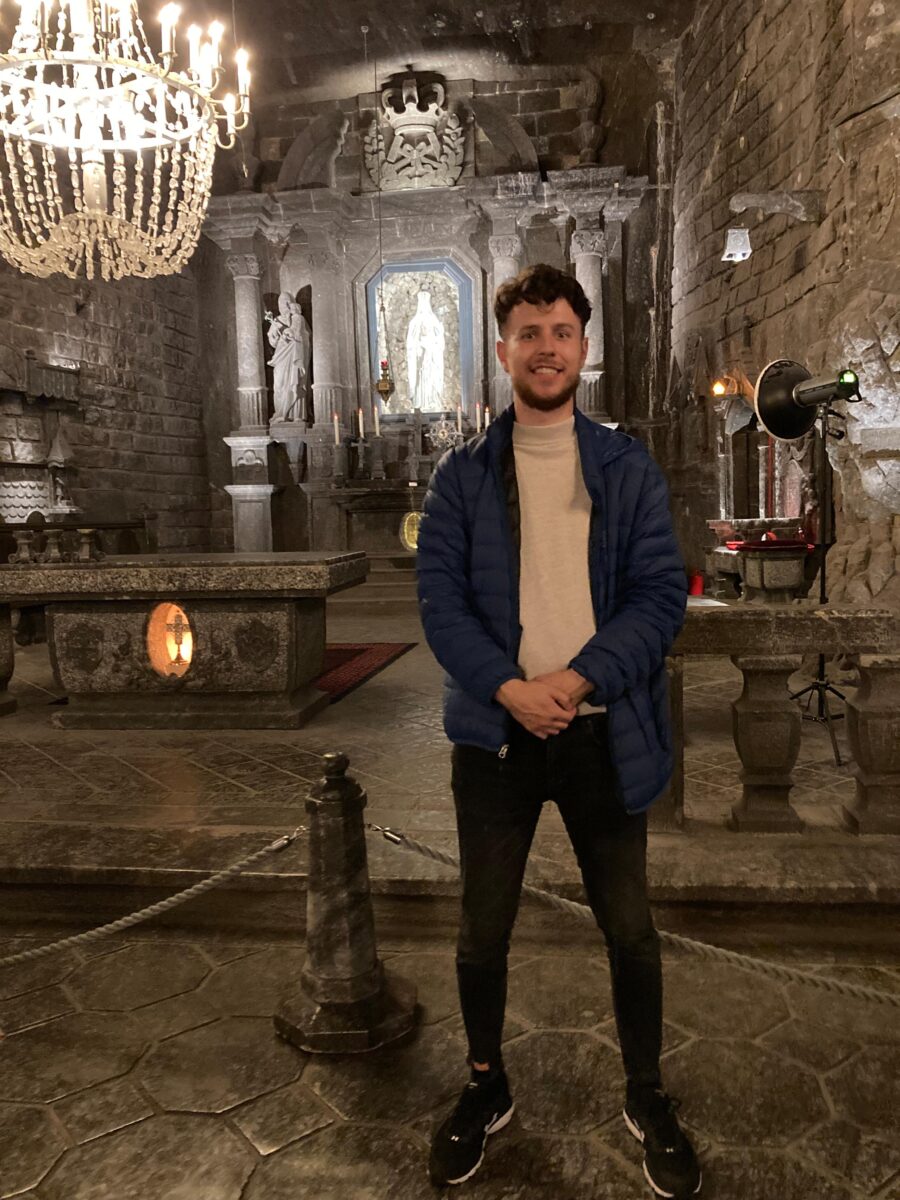
Additionally, the main attraction is to see the sculptures made entirely of salt. They stand for some of the key figures in Polish history. But the crown jewel of the mines is definitely the church, with everything made entirely of salt, including a version of the Last Supper, the altar, and more. The grand scale of it all is the most impressive part.
To visit the mines, you must take a guided tour with a guide. There are tours in many different languages beyond Polish, including English, French, Spanish, German, Russian, Ukrainian, and Italian. If you want to go on the more rugged Miners’ Route, the tours are only in Polish or English. However, I found the dialogue of the guide not the most necessary, so I did the tour in Polish to save money (see later).
Opening Hours: The Tourists’ Route is open from 8 AM to 7 PM every day except some holidays. The Miners’ Route is open daily from 10 AM to 5 PM.
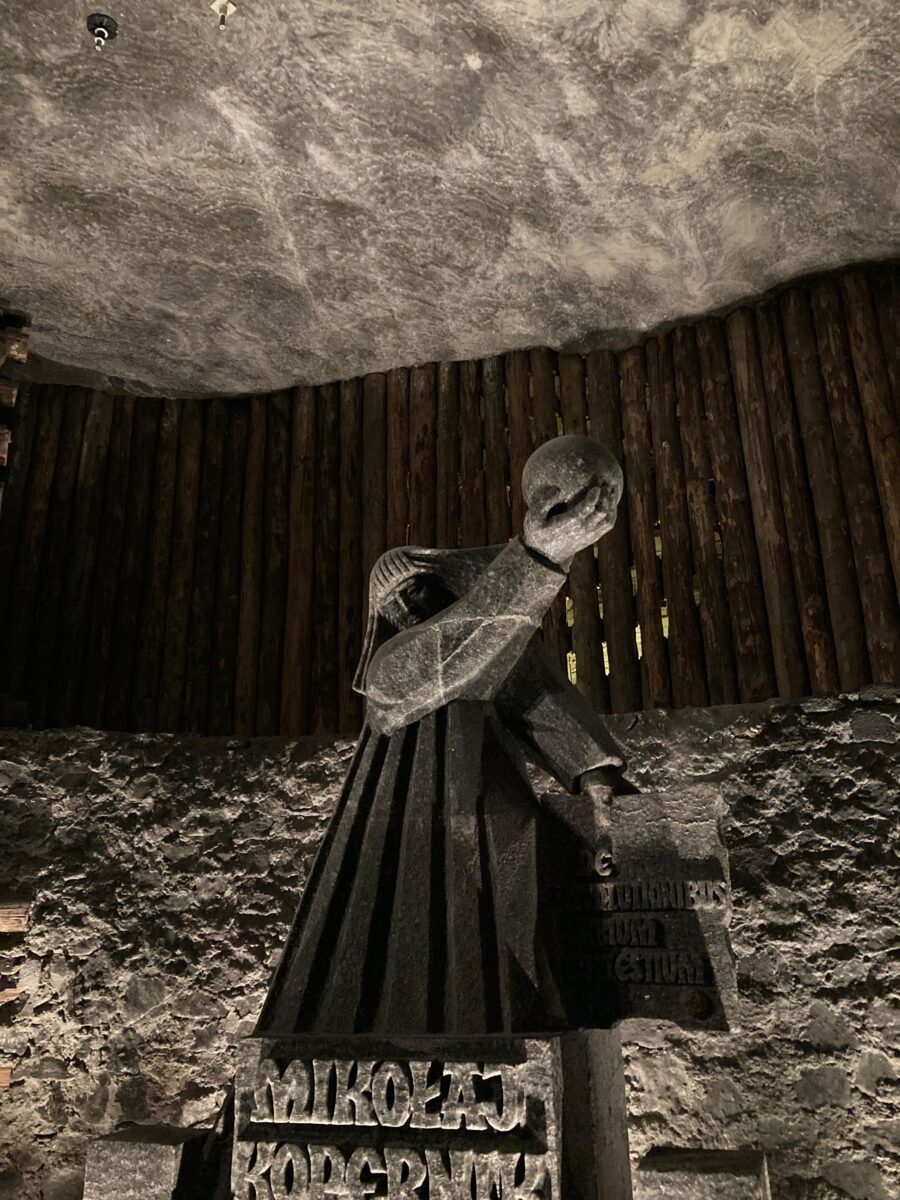
Cost of Admission: The regular ticket for the Polish tour of the Tourists’ Route or the Miners’ Route costs 92 PLN. Tours in Polish are every hour, while other languages leave at different times, and are also more expensive, with the English ticket costing 126 PLN per person. It is a costly endeavor, but I found it worth it. There are student discounts, and family tickets available. Buying tickets online is recommended.
Travel Information: Once in Kraków, there is a regular bus and train service to Wieliczka from the city center, but of course parking is also available for a fee. The trains leave from the main Kraków station quite often, take around 25 minutes, and cost between 8 and 11 PLN per person. Or you can take the very popular 304 bus, which takes about an hour to get near the train station, but also makes many stops near the Old Town to the west, and near Wawel Castle. The bus costs between 3 and 5 PLN each way.
13. Morskie Oko
Zakopane, Lesser Poland | Location | Website
Description: Zakopane is one of the coolest cities to visit in Poland, due to its stunning the nature. The landmark attraction is certainly Morskie Oko, Poland’s most popular hike. Whether it is the winter or summer, this beautiful lake, surrounded by the highest peaks of Poland in the Tatras of Tatra National Park. Morskie Oko translates to “eye of the sea,” and the ever-clear waters of the lake make its name very fitting. Hundreds of thousands of people hike to it every year, and you should join them.
The hike itself is not super challenging. It is more of a long gradual uphill walk, with most of the hike being paved, with restrooms along the way. You can also opt for a horse-driven carriage to the top for an extra fee. Once you reach the top, you can admire the lake from the Morskie Oko Lodge, which is one of the most sought-out hotels in all of Poland (the waiting list is for over a year!). Then, you can leisurely walk around the lake, admiring Poland’s tallest mountains from below, or hike up a bit more for a stunning view of Morskie Oko from above (which I highly recommend).
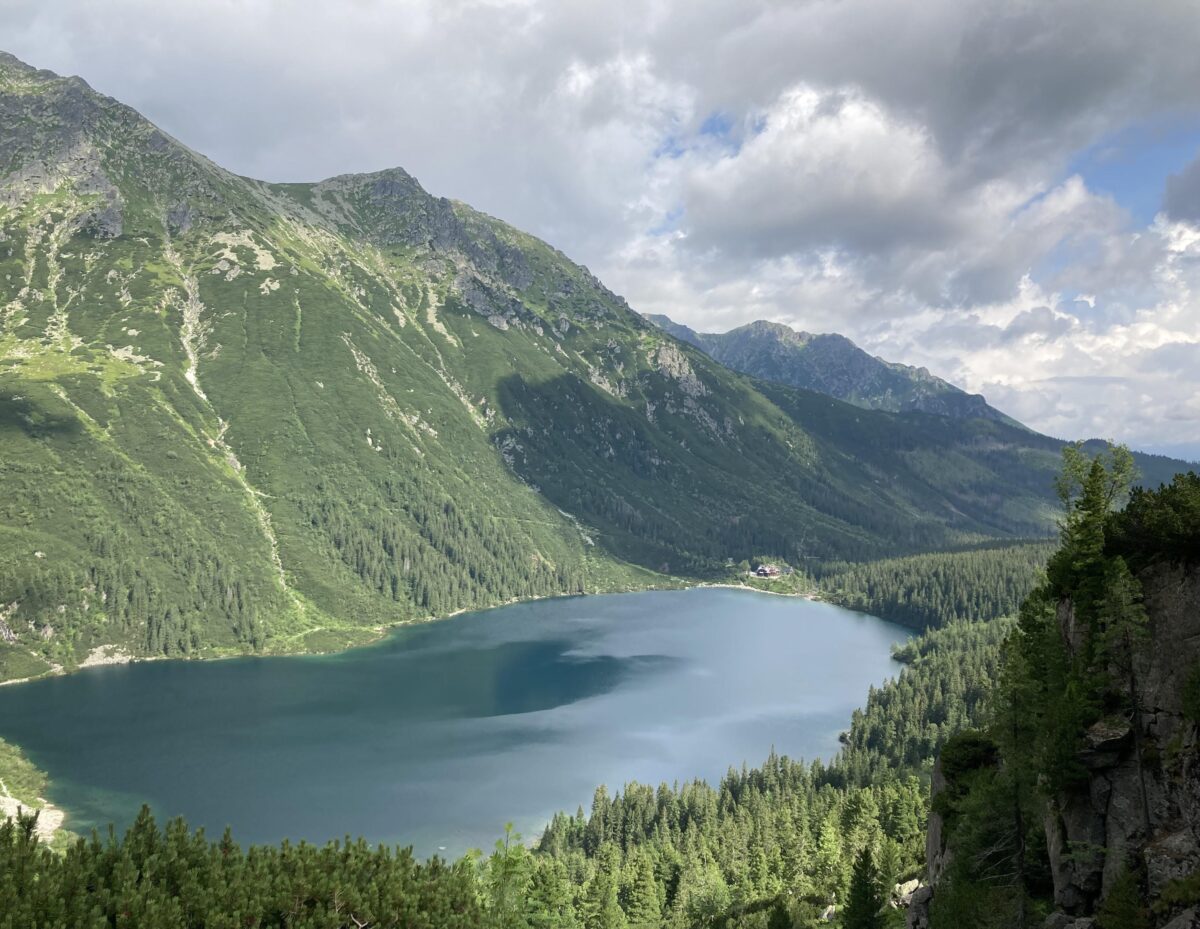
Personally, the lake is beautiful to visit all year round, but the best time is during shoulder season, so the spring or fall, as fewer people are there. If you choose to hike during a popular season, hike as early in the morning as you can to beat the crowds so you can enjoy the lake in some sort of peace! But, regardless of how many people might be joining you to hike Morskie Oko on a particular day, you should undertake this hike if you find yourself visiting Zakopane.
Opening Hours: Morskie Oko is open when the national park is open, which is during the daylight hours for this trail in particular, unless you have some sort of special permission in advance or are staying at the lodge. So, the daylight hours are obviously much shorter in the winter, so thus it is better to start your hike as soon as the sun rises. Check the website linked above for more information about opening hours.
Cost of Admission: A ticket to enter costs 9 PLN or 4.5 PLN reduced. It can be purchased online ahead of time, but the lines move quickly if you want to pay with cash the day of. A minibus will cost around 15 PLN each direction, whereas parking will cost 55 PLN per day. Using the horse-drawn carriage will add an extra 70-80 PLN per person in each direction to your trip.
Travel Information: I have a complete guide to Morskie Oko based on my experiences that is linked here. Zakopane is the closest somewhat major city, and you can easily drive or take a minibus to the start of the Morskie Oko hike from there.
14. Słowiński National Park
Łeba, Pomerania | Location | Website
Description: Słowiński National Park (SPN) is one of the most unique natural features in Poland, but also even in Europe, making it one of the necessary landmarks in Poland to visit. SPN is in the far north of Poland along the Baltic Sea. The Baltic Sea in Poland is famous for its sandy beaches, and the sand of SPN is what makes it famous. The dunes of SPN are some of the fastest moving in the world. In fact, the lake within the national park used to be connected to the sea as a bay, but the relentless dunes have closed off that entry.
So, going to SPN means seeing some of the most stunning sand dunes in Poland, and taking long walks through the many forests of the massive park. The most popular dunes in the park are those at Wydma Łącka. There are also museums available, such as the SNP Museum of Nature. If you want a stunning view of the lakes in the park and the Baltic, consider climbing Rowokół. All in all, this park is one of the most beautiful parts of Poland, and a day trip from nearby Gdańsk is 100% worth it.
Opening Hours: Each attraction has its own hours, so I would recommend checking out the website for which attractions you are most interested. But, for example, the watch tower is open only during the peak season, from 10 AM to 4 PM in May, June, and September, and from 10 AM to 7 PM in July and August.
Cost of Admission: From May until September, the busy season, admission into the park costs 8 PLN per person per day, or 4 PLN reduced. If you want to spend more time, there are tickets available for 3 days, 7 days, 14 days, and 30 days, which are a good deal. The attractions within SNP cost extra. The Nature Museum costs 16 PLN and 12 PLN reduced, and the watchtower costs 8 PLN or 4 PLN reduced. For more information about all their prices, visit their website linked above.
Travel Information: The best way to get around is by car, as the park’s main sites are spread out and not well served by bus or train services. So, your best bet is to arrive in Gdańsk and rent a car there, and then work from there. The city of Łeba has the most lodging options but is to the extreme east of the park. Please also note that there are parking fees within the park, and if you want to take commercial photos, there are hefty fees, all detailed on their website.
BONUS: Looking for more inspiration? Have more time in Poland? Consider visiting Białowieża Forest, a UNESCO World Heritage Site, and one of the most forested areas in all of Poland. It is also home to the largest population of European Bison, and other animals. It is found closest to the major Polish city of Białystok, which is a bit off the beaten path, hence why it is not included in the list proper.
Furthermore, consider visiting Krzywy Las, a forest full of crooked tress all bending in a similar direction, in similar spots on the trees. It is a phenomenon with no concrete evidence of why it exists, making it a unique place to visit, hence why it was featured in the Atlas Obscura, a great source for off-the-beaten-path tourist sites. This is why this forest is not on the list proper, as it is found about an hour away from Szczecin, the hardest major Polish city to get to unless you are arriving from Berlin.
Landmarks in Poland: Historical Sights
15. Auschwitz-Birkenau **
Oświęcim, Lesser Poland | Location | Website
Description: While some Poles may find my placement of this on the list as controversial, let me stress that this is a list of landmarks in Poland, and while it was the German Nazi forces who built this concentration camp on Polish land, it is still an influential landmark in Poland. Additionally, Auschwitz is one of the most visited landmarks in all of Poland, and a huge reason why Kraków is the most-visited city in all of Poland. Some of the greatest atrocities known to man were committed here, and a visit to Auschwitz means reflecting on this horrible moment in history and aspiring to not repeat it.
Today, there is a sobering museum to visit, where you can see relics leftover from the horrors of the camp. You can also take a tour of the grounds, perhaps the most emotional part of a trip to this UNESCO World Heritage Site. I would recommend not taking any pictures on the trip, and rather focusing on reflecting on the memorial and what happened in the past. Do not be like some of the so-called influencers who pose in front of the gates.
Opening Hours: The Museum is open every day except New Years, Christmas, and Easter. The hours depend on the month, so I would visit their website for the exact information. Additionally, it is recommended to save at least 3 hours to be able to comfortably see everything the site has to offer.
Cost of Admission: Admission to the grounds and museum is completely free, but you must reserve a place online before coming, so visit the website linked above to find the place to do so. You can also choose to join a guided tour for a fee. If you are coming in a large group, 10 or more people, you must pay for a guide.
Travel Information: Some logistical things to mention are that taking anything from the grounds is strictly prohibited, and you can face large fines and jail time for doing so. Additionally, photography on the grounds has some complicated rules, so I would check their policy if you believe what you are doing falls under commercial photography. Additionally, the museum does not recommend those under 14 to attend the memorial.
Oświęcim is the closest city, and there is train and bus service from both Kraków and Katowice. You can also drive from either, there is paid parking available. Or, if you are in Kraków, there are many guided tours that will include admission fees for group travel and transport, if you find that easier. But bus and train service are easy if you want to avoid unnecessary fees.
16. Panorama Racławicka
Wrocław, Lower Silesia | Location | Website
Description: I had never heard of this amazing piece of artwork until my girlfriend said that it was certainly one of the landmarks in Poland I had to include on this list. And, upon further study, it is clear why this panorama is such a well-visited site by all who visit the Polish city of Wrocław. What is depicted is the Battle of Racławicke, a very important battle in Polish history, in which the Polish-Lithuanian commonwealth fought back against Russian and Prussian influence.
The painting itself is a 360-degree panorama that depicts the valor of the battlefield on that day. The painters Jan Styka and Wojciech Kossak, as well as a whole host of helpers, painted this massive painting in the now Ukrainian city of Lviv at the end of the 19th century. After WWII, it was moved to its current home. Lighting and nature effects help add to the immersive experience of this painting, and this is a must visit if you find yourself in Wrocław.
Opening Hours: The Panorama is open every day from 8:30 AM to 7 PM. Tickets are for 30-minute windows, so this means you only get a MAXIMUM of 30 minutes to see everything, which should be enough in my opinion.
Cost of Admission: A regular ticket is 50 PLN, with a reduced ticket being 35 PLN. However, buying a ticket also gives you free admission to three other museums in Wrocław, so it is not an unreasonable cost if you choose to attend the other three museums, these being the National Museum in Wrocław, the Ethnographic Museum, and the Four Domes Pavilion of the Museum of Contemporary Art.
Travel Information: As mentioned early in this article, Wrocław, being a very large Polish city, is well connected by public transport, including through the convenient airport with budget airline service, and long-haul train and bus from all over Poland. The Panorama is found just east of the historic Old Town, so it is easy to get there from the main attractions of Wrocław.
17. Westerplatte
Gdańsk, Pomerania | Location | Website
Description: This unassuming peninsula found east of the previously mentioned Old Town of Gdańsk, is quite important. Here, an event happened that started one of the most influential events in recent history, and perhaps one of the most well-known historical events in all human history. Here, the German Nazi forces landed in their quest to invade Poland, with Polish forces fighting back for the first time here, making it the sight of the first battle of WWII. For seven days, 180 Polish soldiers were able to hold back 570 Germans, preventing Germany from sweeping into the coastal regions of Poland as quickly as they wanted.
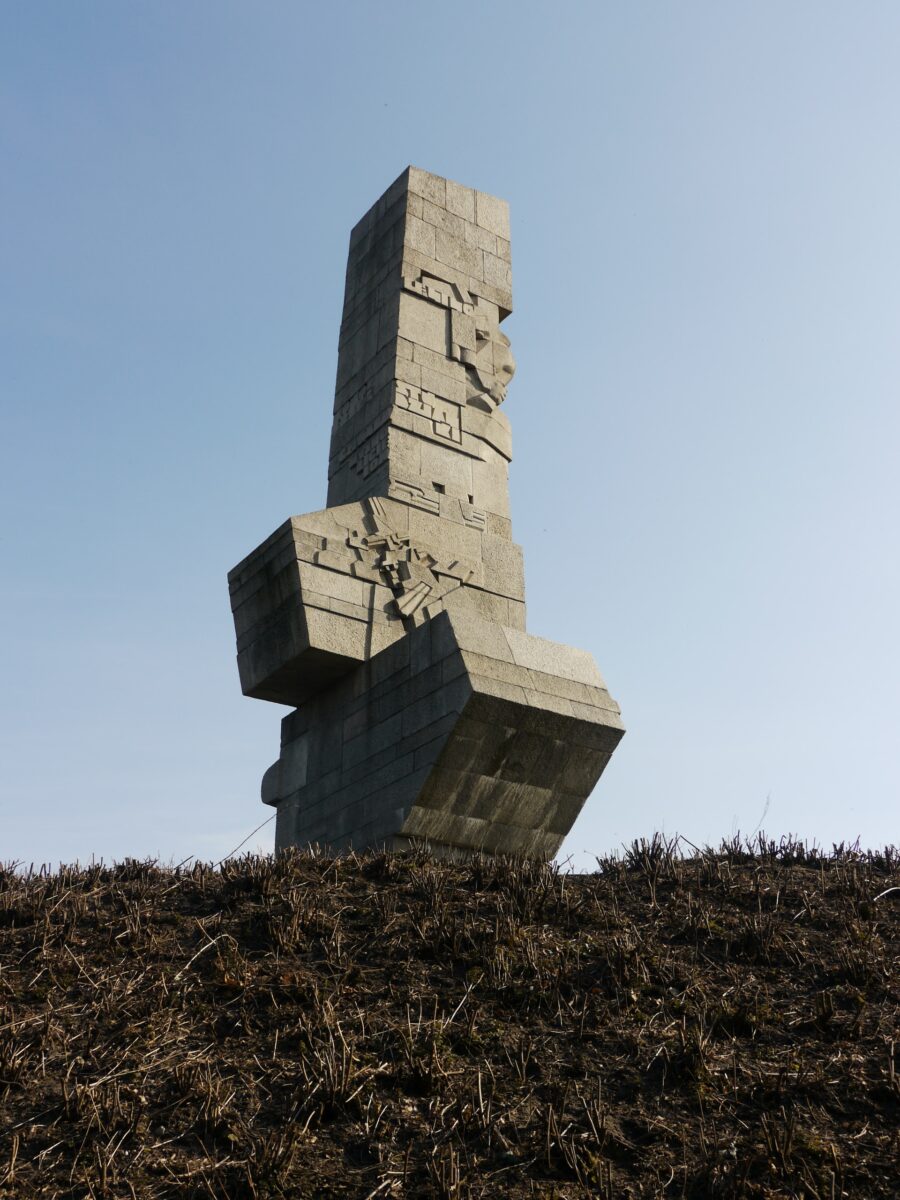
Today, you can see the ruined barracks where these soldiers had their last stand, as well as a guard tower overlooking the Baltic Sea. You can also see the distinctive monuments throughout the area dedicated to the battle or take a walk on the beach. If you find yourself in Gdańsk, going to Westerplatte is worth a visit if you are interested in history.
Opening Hours: You can visit anytime, but when the sun is up is definitely the best time. In the summer, early in the morning is good to beat the heat. Or, visit at sunset for a stunning sunset over the Baltic at the attached beach.
Cost of Admission: Everything outdoors is free to view as part of the monument.
Travel Information: Westerplatte is found within Gdańsk, which is well connected to other cities in Poland, and is served by an international airport. Getting to Westerplatte is best done by driving, but you can also take public transportation. From the train station, a bus takes between 15-20 minutes to get there. However, these buses only run every 30-60 minutes, so be prepared for this.
18. Biskupin
Biskupin, Kujawa-Pomerania | Location | Website
Description: Biskupin is one of the most important archaeological discoveries in Poland, and thus one of the most important landmarks in Poland. Biskupin was discovered when the nearby lake had water levels dropped more than ever before, which revealed a lost settlement that had not been seen for millennia. Excavations followed, and today, you can see a recreation of the Lusatian village that once sat here in Poland, with the Lusatian peoples being some of the earliest settlers of Poland.
In Biskupin you will find a large gate and ramparts to walk around, as well as reconstructed huts where you can see recreations of what life was like in the BC era. You can also walk around the “streets” of the village, an example of order even in eons past. And, even better, the fortifications are constantly updated to keep them historically correct, as research continues. So, if you are interested in learning about some of Poland’s earliest settlers at a site compared to Pompeii by some, visiting the museum and reserve is a definite must.
Opening Hours: The museum is open daily except for New Years, Easter, All Saints Day, and Christmas. Regardless of the month, the museum always opens at 9 AM. From May to September, the museum closes at 6 PM. In April and October, the museum closes at 5 PM. Finally, from November to March the museum closes at 4 PM. From October to April, only the museum is open, and the reserve is empty.
Cost of Admission: A ticket costs 23 PLN, or 15 PLN reduced. Free admission is available for those 6 or younger. You can also buy a 4-person family ticket for 62 PLN.
Travel Information: Biskupin is definitely a remote location. The closest city to it is Bydgoszcz. It is also not far from a later location on this list, in Gniezno. So, Biskupin is best visited with a car on your own. However, there are day-long tours available from the two closest cities, Bydgoszcz as mentioned and Poznań, but these are mostly available during the summer.
19. Jasna Góra Monastery
Częstochowa, Silesia | Location | Website
Description: The Jasna Góra Monastery is a massive shrine dedicated to the Virgin Mary, and perhaps the most important religious site for Catholics in Poland. However, even for non-Catholics it is an interesting site to visit. The reason this monastery holds so much importance is due to the placement of an important Catholic icon, the Black Madonna of Częstochowa. This painting is credited with protecting the monastery from the Swedes during an invasion in the 17th century, which in turn led to a resurgence of the Polish army in pushing the Swedes out of the country. Thus, the icon is revered both for religious and patriotic reasons.
You can walk around the monastery’s many facilities freely. There are many buildings on sight, but the main sight is of course the icon. You will find many pilgrims coming here to worship, with millions coming every year, some on foot. For further patriotism, you can also find a less-religious item, this being famous Polish Solidarity leader Lech Wałęsa’s Nobel Peace Prize. All in all, the grandeur of this sight and spectacle of it all makes it one of the landmarks in Poland you need to visit if you can.
Opening Hours: The entrance gates to the sanctuary are open every day from 5 AM to 9:30 PM to accommodate the pilgrims coming to visit. There are luggage rooms available most of the day too.
Cost of Admission: Visiting the monastery is 100% free. If you feel like it, you can of course leave a donation, but this would of course be going to the Catholic Church.
Travel Information: The city of Częstochowa, where the monastery is, is a decent-sized city with good infrastructure available if you would like to stay. However, you can also take easy day trips here. It is only about 2 hours from Warsaw by car and is even closer to Katowice. There is a train and bus service available all the time if you do not have a car.
Please note that photos are not allowed in most places on site. Also, there is required etiquette, either silence or low voices out of respect for those worshipping. Additionally, when approaching the icon, you will get a ton of dirty looks if you do not kneel to the icon, and then kneel your way around the icon. Also, be prepared for people insisting you take handouts from them, and make sure to watch out for scammers that unfortunately take advantage of people here.
20. Gniezno Cathedral
Gniezno, Greater Poland | Location | Website
Description: This unassuming cathedral finds it placed last on the list. While I would not say that it is the most important site in Poland, it is still one of the most important historical landmarks in Poland. Here at this cathedral, some of the earliest Polish monarchs where coronated, and for nearly 1000 years, the Polish church ran from this cathedral. The cathedral was initially completed in the 11th century and is in the Brick Gothic style common in many places in Teutonic-influenced part of Poland. The most famous aspect of the design is the massive bronze doors from the 12th century.
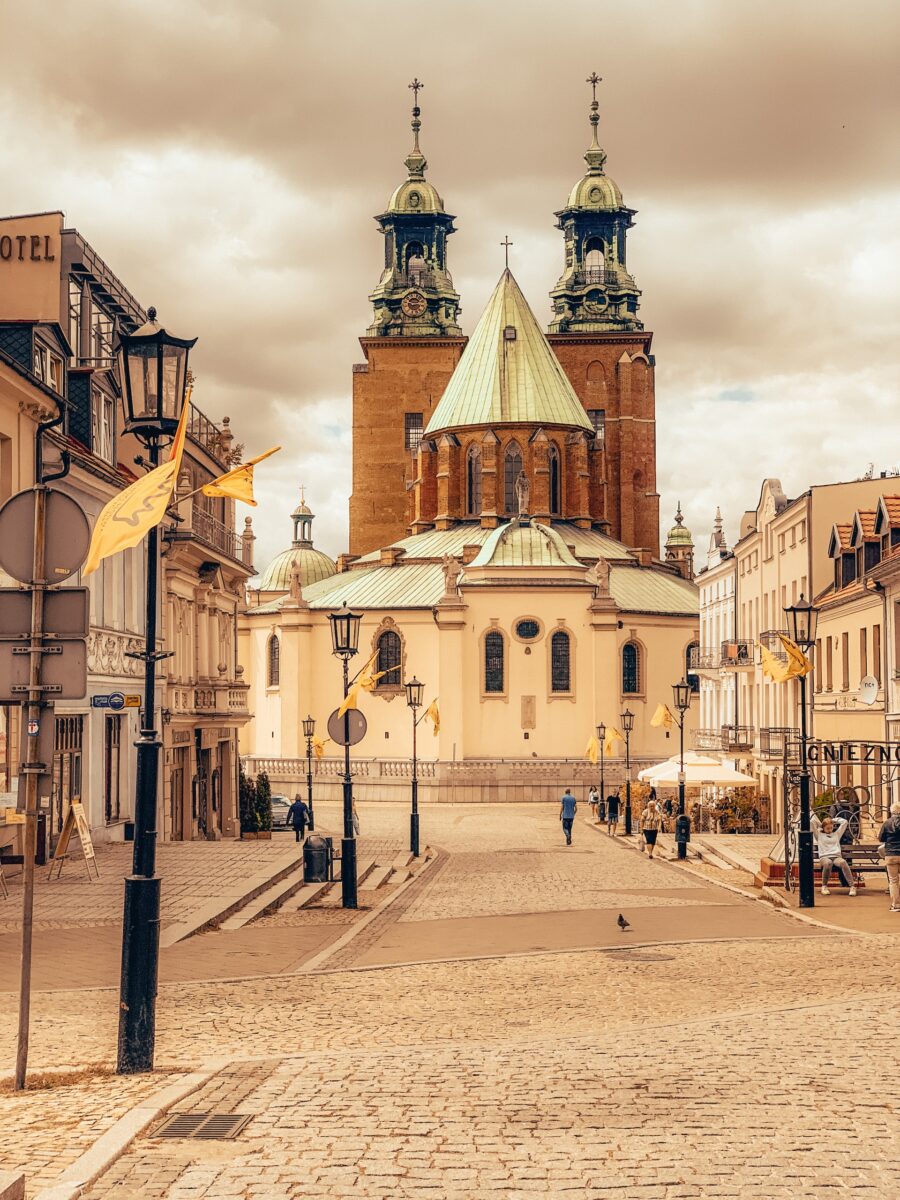
Here, you can see where the first king of Poland was crowned in 1025, and admire the silver coffin of St. Adelbert, a relic in honor of the Catholic bishop who preached to the pre-Christianized Slavs in Poland. It is thus also a common pilgrimage site. But, for those of you who are not Catholic, the cathedral is beautiful to admire, and the history is great. And, given its location near some major Polish cities such as Poznań, it is not unreasonable to visit.
Opening Hours: I found conflicting accounts of when the cathedral is open. Google says it is open from 7 AM to 7 PM every day. However, the best information I could find is that the cathedral is open from 9 AM to 5 PM every day except for Sundays.
Cost of Admission: An all-inclusive pass to see everything at the cathedral, including the doors, the vaults, and the viewing terrace, as well as a dedicated museum to learn all the history, costs 31 PLN or 22 PLN reduced. You can also buy individual tickets for each part, with just seeing the doors costing 10 or 7 PLN, and the museum costing 13 or 9 PLN.
Travel Information: As mentioned earlier, Gniezno is a mid-sized town about an hour from Poznań. If you visit there, it is easy to book a bus or train to the city and admire the town while visiting the cathedral. Driving is also a convenient way to visit, as you can then drive a little farther and visit Biskupin as well. There are tours available from Poznań as well if you want a more comprehensive experience.
BONUS: If you need an extra historical site to visit, a far-off adventure could be to Krzemionki, a prehistoric flint mining area. These mines are thousands of years old, dating back as far as 3900 BC to the Neolithic era of Poland. Today, you can take an underground tour of this UNESCO World Heritage Site and learn about some of Poland’s earlier residents. The only downside is that it is quite far from everything, in the middle of the smaller major cities of Radom, Kielce, and Lublin. But, if you are dedicated, it could be worth a trip.
Conclusions about Landmarks in Poland
Overall, Poland is a country full of important landmarks to visit, even if there are not as world famous. From beautiful buildings, to historic cities and neighborhoods, to natural beauty like Morskie Oko, there is a landmarks for everyone in Poland. I hope you found yours on this list.

